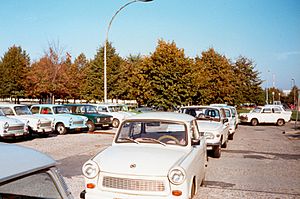Trabant facts for kids
The Trabant (or Trabi) was a series of cars built in the German Democratic Republic. When the first cars were released, people saw them as being innovative. The cars were also easy on fuel, they did not need much fuel. Trabant had a two-stroke engine. The outside of the Trabant was not made with steel or iron, because the German Democratic Republic did not want to import steel and iron for the cars, because that would have been too expensive. Instead, the Trabant was made of Duroplast, a special kind of plastic, made by mixing formica and bakelite, and made stronger with fibres of cotton. They could afford some steel from Russia, and this was used for the engine and the floor, and to give the plastic strength. After the Berlin Wall was opened the Trabant did not sell as much as before, because the people wanted bigger cars that they could get after the wall was opened. Trabants can still be found in East Europe, for example in Hungary.
Contents
Criticism
The Trabant was a small car, good for driving in the city. The two-stroke engine created lots of air pollution, but because of the plastic body, it was stronger and safer than western cars of the same time. It was famous for being better in a crash test than a VW Polo.
Versions
| Version | Years of production | N° of cars produced |
|---|---|---|
| AWZ P70 | since 1954 to 1959 | 36.151 |
| Trabant P50/500 | since 1957 to 1962 | 131.440 |
| Trabant P60/600 | since 1962 to 1965 | 106.628 |
| Trabant 601 | since 1964 to 1990 | 2.818.547 |
| Trabant 1,1 | since 1989 to 1991 | 39.474 |
Between 1957 and 1990, about 3 million Trabants were built. As of January 2005, about 67.000 such cars were still registered.
Gallery
-
Trabant two-stroke engine
-
Trabant 1.1 model with VW Polo four-stroke engine
-
Mural, on the Berlin Wall
-
Easy parking, Dobrich, Bulgaria.
Images for kids
-
Many Trabants like this one, photographed in Leipzig in 1990, were abandoned after 1989.
See also
 In Spanish: Trabant para niños
In Spanish: Trabant para niños
























